38th (Irish) Brigade
The 38th (Irish) Brigade, is an infantry brigade formation of the British Army that served in the Second World War. It was composed of Irish line infantry regiments and served with distinction in the Tunisian and Italian Campaigns. A similar formation, the 38th Brigade had served in World War I, but contained no Irish connection.
| 38th (Irish) Infantry Brigade 38 (Irish) Brigade | |
|---|---|
_Brigade.jpg.webp) Current insignia of 38 (Irish) Brigade. | |
| Active | 1942–1947 2007–present |
| Country | |
| Branch | |
| Type | Adaptable Force Brigade |
| Size | Brigade |
| Part of | Regional Command[1] |
| Garrison/HQ | Thiepval Barracks, Lisburn |
| Motto(s) | "Ubique et Semper Fidelis" |
| Commanders | |
| Current commander | Brigadier Christopher D. Davies[2] |
| Notable commanders | The O'Donovan |
| Insignia | |
| Identification symbol |  Insignia of the 78th Battleaxe Division. |
History
The 38th (Irish) Infantry Brigade came into existence on 13 January 1942 by the re-designation of the 210th Independent Infantry Brigade (Home), a Home Defence formation organised in October 1940. The 210th Brigade had been serving in Dorset County Division. When that division was disbanded on 24 November 1941, 210 Brigade transferred to the 1st Infantry Division. By then, all of 210 Brigade's English home defence battalions had been posted away and were replaced by the 1st Battalion, Royal Irish Fusiliers, the 6th Battalion, Royal Inniskilling Fusiliers and the 2nd Battalion, London Irish Rifles. Of the three battalions, only the 1st Royal Irish Fusiliers had seen active service, fighting in the Battle of France where they were forced to retreat to Dunkirk and were subsequently evacuated to England.[3]
In June 1942, the brigade was transferred from the 1st Infantry Division to the 6th Armoured Division and it landed in North Africa with the division on 22 November 1942, as part of the British First Army. In March 1943, it exchanged with the 1st Guards Brigade and joined the 78th Battleaxe Infantry Division and fought with distinction throughout the rest of the Tunisian Campaign. In late April, the 38th (Irish) Brigade played a lead role in the capture of the German defensive positions in the mountains north of Medjez-el-Bab and the campaign ended in mid-May, with almost 250,000 Axis soldiers surrendering. The brigade were the first marching troops to enter Tunis on 8 May 1943.[4]

After a short rest, the brigade again saw action in the Allied invasion of Sicily (in particular the capture of Centuripe), and in the Italian Campaign, spearheading the British Eighth Army's advance to the Volturno Line, and later at the Battle of Monte Cassino and at Lake Trasimene. Shortly afterwards, the brigade was sent to rest in Egypt. While there, the 6th Inniskillings was disbanded and the men transferred to the 2nd Battalion, another Regular Army unit, which had arrived from 13th Brigade of the 5th Division, and the surplus men were transferred to fill gaps in the other battalions of the brigade.[5]

The rest was short-lived, however, and the brigade soon returned to Italy where it was involved in fighting north of Florence, followed later by Operation Grapeshot. During May 1945, it was (briefly) detached to both 46th Infantry and 6th Armoured Divisions and the brigade then was allotted occupation duties in Carinthia in southern Austria, before being formally disbanded in April 1947.[6][7]
Order of battle
The 38th Brigade was constituted as follows during the war:[7]
- 1st Battalion, Royal Irish Fusiliers
- 2nd Battalion, London Irish Rifles
- 6th Battalion, Royal Inniskilling Fusiliers (disbanded 5 August 1944)
- 2nd Battalion, Royal Inniskilling Fusiliers (from 26 July 1944)
Commanders
The following officers commanded the 38th Brigade during the war:[7]
- Brigadier Morgan O'Donovan (12 January 1942 – 1 July 1942)
- Brigadier Nelson Russell (1 July 1942 – 20 February 1944)
- Brigadier Thomas (Pat) Scott (from 20 February 1944)
Formations served under
Formations that the brigade served under included:[8]
- 1st Infantry Division 25 November 1941 – 7 June 1942
- 6th Armoured Division 9 June 1942 – 16 February 1943
- 'Y" Division 16 Feb 43 – 15 March 1943
- 78th Infantry Division 15 March 1943 – 28 March 1943
- 46th Infantry Division 29 March 1943 – 6 April 1943
- 78th Infantry Division 7 April 1943 – 10 May 1945
- 6th Armoured Division 10 May 1945 – 13 May 1945
- 46th Infantry Division 13 May 1945 – 18 May 1945
- 78th Infantry Division 18 May 1945 – 31 August 1945
21st century
38 (Irish) Brigade reformed on 1 August 2007, as part of a new combined divisional / brigade structure called HQ Northern Ireland and 38 (Irish) Brigade after the disbandment of HQ Northern Ireland and has its headquarters at Thiepval Barracks in Lisburn.[9]
The 38 Brigade subsequently came under command of the 2nd Division, the regional division for Scotland, the North of England and Northern Ireland, on 1 January 2009. It is now the Regional Brigade responsible for administering the Army Reserve within Northern Ireland. This was the culmination of a drawdown of military headquarters in Northern Ireland, which had seen the disbandment of 3 Infantry Brigade, 8 Infantry Brigade, 39 Infantry Brigade and 107 (Ulster) Brigade.[10]
Today the Army Reserve soldiers from the brigade have served on operations supporting the Regular Army in the Balkans, on Operation TOSCA in Cyprus, on Operation HERRICK in Afghanistan and Operation TELIC in Iraq. At home the Brigade has the key role of providing the Civil Contingency Reaction Force for Northern Ireland. The Brigade Headquarters is also regionally aligned with the Republic of Ireland as part of defence engagement.[11]
Current formation
Previously, 2nd Battalion The Rifles[12] - A Regular Infantry Battalion based in Lisburn, Northern Ireland. and 8th Battalion The Rifles (The Rifles' Reserve Infantry Battalion of the North East, Yorkshire and West Midlands, has bases in North East, South and West Yorkshire, Birmingham and Shropshire) were part of the brigade. As a result of the Field Army restructuring in August 2019, these regiments moved to 51st Brigade.[13][14] Furthermore, 1st Battalion The Royal Regiment of Scotland[15] has shifted to a Specialised Infantry Battalion and will move to Aldershot.[16]
It maintains oversight over the following Army Reserve units:[17]
- The Scottish and North Irish Yeomanry
- 206 (Ulster) Battery 105th Regiment Royal Artillery
- 591 (North Irish Horse) Signal Squadron 32 Signal Regiment
- 2nd Battalion Royal Irish Regiment
- 152 (North Irish) Regiment RLC
- 253 (North Irish) Medical Regiment
- 204 (North Irish) Field Hospital
- 157 Field Company 106 Battalion REME
- 62 Company 6 Military Intelligence Battalion
References
- "HQ Regional Command". army.mod.uk. British Army. 1 August 2019. Retrieved 1 August 2019.
38 (Irish) Brigade and 160 Infantry Brigade and HQ Wales
- Mackie, Colin (21 October 2019). "Generals October 2019" (PDF). gulabin.com. Colin Mackie. Retrieved 21 October 2019.
Brigadier Christopher D. Davies (late Princess of Wales’s Royal Regiment): Commander, 38th (Irish) Brigade, September 2019
- "1st Battalion Royal Irish Fusiliers and the fighting retreat to Dunkirk". Wartime NI. Retrieved 11 July 2020.
- "38 (Irish) Brigade beat off German attack, Tunisia". Royal Irish. Retrieved 11 July 2020.
- Ford pp. 242-243
- The Irish Brigade
- Joslen, p. 373.
- "38 (Irish) Infantry Brigade". Orders of Battle.com.
- Hansard, proceedings of the British Parliament
- "Northern Ireland (Future Garrison Structure)". Hansard. 10 May 2006. Archived from the original on 23 June 2006. Retrieved 19 September 2018.
- "Information regarding British Army brigades being regionally aligned" (PDF). assets.publishing.service.gov.uk. Ministry of Defence UK. 2 August 2019. Retrieved 9 April 2020.
Responsible Organisation HQ 38th Infantry Brigade Region Republic of Ireland
- "1st Bn, The King's Royal Rifle Corps: Deployments". 16 December 2007. Archived from the original on 16 December 2007. Retrieved 19 August 2018.
- "Army restructures to confront evolving threats". Ministry of Defence. London. 31 July 2019. Retrieved 1 August 2019.
- "Field Army Restructuring Battalion movements" (PDF). whatdotheyknow.com. whatdotheyknow. 11 September 2019. Retrieved 12 September 2019.
2nd and 8th Battalions The Rifles have transferred to 51st Infantry Brigade from 38th(Irish) Brigade
- "1st Bn, The Royal Regiment of Scotland: Service". 17 November 2007. Archived from the original on 17 November 2007. Retrieved 19 August 2018.
- "Scottish Army units face 'upheaval' under reforms". BBC News. 16 December 2016. Retrieved 12 September 2019.
- "38 Irish Brigade". army.mod.uk. British Army. 25 October 2020. Retrieved 25 October 2020.
Bibliography
- Ford, Ken (2003) [1999]. Battleaxe Division. Stroud, UK: Sutton Publishing. p. 273 pages. ISBN 0-7509-3199-X.
- Doherty, Richard (1994) [1993]. Clear The Way! History of the 38th (Irish) Brigade. Dublin, Ireland: Irish Academic Press. p. 336 pages. ISBN 0-7165-2542-9.
- O'Sullivan, Edmund (2007) [2007]. All My Brothers. Slough, UK: Edmund O'Sullivan & Family. p. 232 Contains an eyewitness account of serving in the 2nd Battalion of the London Irish Rifles from October 1939 March 1946 including O'Sullivan's involvement in Irish Brigade battles in Tunisia, Sicily and Italy, including at the Battle of Cassino in May 1944.
- Joslen, H. F. (2003) [1990]. Orders of Battle: Second World War, 1939–1945. Uckfield: Naval and Military Press. ISBN 978-1-84342-474-1.
External links
- 38 (Irish) Brigade
- The Long, Long Trail
- Irish Brigade The Story of the 38th (Irish) Brigade during the Second World A website containing information and eyewitness accounts. The site also has , the story of the Irish Brigade written by TPD Scott, who commanded the brigade from February 1944 until the end of the war.